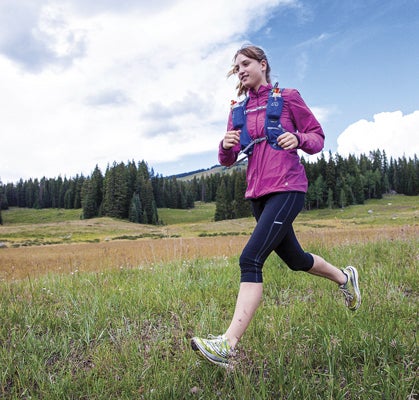New perk! Get after it with local recommendations just for you. Discover nearby events, routes out your door, and hidden gems when you sign up for the Local Running Drop.
Pacing trail workouts, raw food diets and proper foot placement

Photo by Jason Hatfield
I have been a competitive road runner and recently converted to trail running. I’m not sure how to calculate my pace for workouts. For example, if a workout suggests 20 to 25 seconds slower than 5K race pace, should I use my 5K road race pace, or run a time trial on a trail? And, how do I take the hills and terrain into account when figuring out training pace?
—Reid Axman, Phoenix, AZ
Training with pace gives runners a quantifiable goal. Many great pace calculators exist to help you figure out how fast a five-minute-50-second-mile runner might expect to run 800 meters.
Transitioning from the track to the trails, though, can be tough. The uneven terrain, mountain climbs and occasional bushwhacks don’t lend themselves to keeping a consistent pace. You need to shift your thinking. As endurance coach Gordo Byrn, founder of EnduranceCorner.com, says, “The key is to run the equivalent effort and release yourself from pace expectations.”
With each run, have a goal. Whether you intend to run easy or at race pace, choose your route accordingly. For example, a recovery run in which you keep your heart rate low is more easily accomplished on a flat trail without big climbs. “Downhills are great for working on quickness/cadence, and the uphills should be capped by effort/heart rate, rather than pace,” says Byrn.
The unpredictability of the trails means a single workout can run you through the entire gamut of heart-rate zones and effort levels. Therefore it’s easier to focus on overall effort. As Byrn says, “The trails are a specific skill, and pace at all efforts improves with trail time.”
Next page: “Should I take a B-vitamin supplement when following a raw diet?”
I am experimenting with a raw diet, which seems to provide more energy and strength. The longest I have eaten only raw foods is seven days. Should I supplement with a vitamin-B complex to be safe?
—Lucus DeBuhr, Fayetteville, AR
A raw-food diet generally consists of uncooked, unprocessed foods or foods that are never heated above 40 °C (104 °F). It might seem healthy at first blush, but has the potential to leave you with serious nutrient deficiencies. Registered Nutritionist Amy Kubal says, “A raw-food diet can be dangerously low in some essential nutrients, including Omega-3 fatty acids, vitamin D, calcium, iron and some of the B vitamins.” To be “safe,” you should eat all the wonderful natural foods available to us on Earth—a variety of plant and animal products raised and grown in the best possible way—raw and cooked.
All the vegan athletes I know supplement with B12; raw-food adherents with the same animal-product restrictions will likely require similar nutritional intervention. Without animal products, it’s nearly impossible to get B12 through your diet.
With that said, the question of whether you should supplement with B vitamins, while on your raw diet, is pretty cut and dried—yes, you should. B vitamins help make red blood cells and normalize brain function. Severe depletion of B vitamins may lead to anemia, a condition in which you don’t have enough healthy red blood cells to carry adequate oxygen throughout the body. Runners with this condition often feel lethargic, which will essentially crater your training.
Kubal says, “A vitamin-B12 supplement or a good vitamin-B complex will help you maintain your energy and give you the Bs you aren’t getting from the foods.” The first step however is to get your levels tested.
Next page: What’s the best stride technique for protecting my knees?
I had a knee replacement four years ago, and just began road racing 18 months ago including finishing one marathon. I recently discovered the wonderful world of trail running and am hooked. What is the best technique for stride and foot placement that will minimize damage to my knee while allowing me to conquer the ascents and descents of the trails? Mahalo nui loa.
—Tig Kehm, Honolulu, HI
“Landing with your foot under your hips is the optimal landing position, as anything forward of that creates greater force on the knee joint,” says Brian MacKenzie, author of Power Speed ENDURANCE: A Skill-Based Approach to Endurance Training. Recent research published in the British Journal of Sports Medicine suggests that running barefoot may encourage the low-impact landing that MacKenzie refers to, thereby reducing patellofemoral joint stress. However, impact forces don’t simply disappear. With improved running form they may be relocated to, for example, ankles and feet—so it’s important to take a tempered approach to form overhauls and ease into them.
Find out more from coach Matt Hart on www.coachingendurance.com.